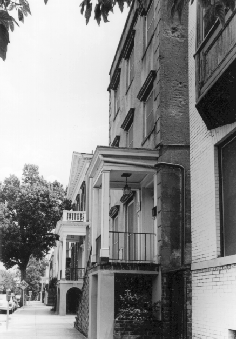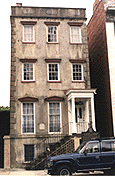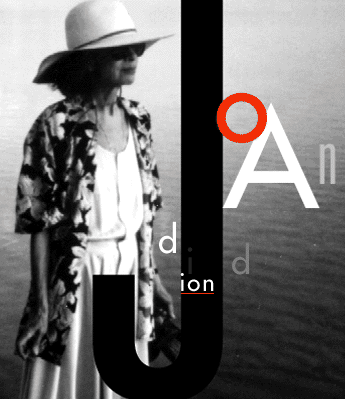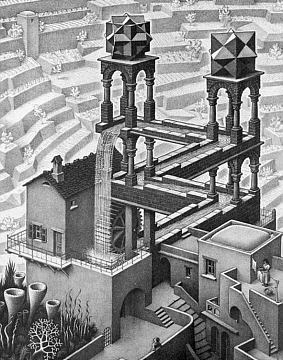
In looking at the two
writers, Flannery O'Connor and Joan Didion, we see the problem of the advancing
centuries, and the issue of naming time frames. Both O'Connor and Didion
somehow have to be included in Contemporary Writers as a category, since both of
them are clearly Post Modern (yet nothing about Modernity seems very modern to
us now, it is a century old!). Still, O'Connor and Didion are only
slightly contemporaneous with each other, and Didion is really only slightly a contemporary
of the youngest of our students here. But we will go with
this nomenclature in the absence of any other options!
Flannery O'Connor
"You Can't Be Any Poorer Than
Dead"


Flannery O'Connor was born in Savannah, Georgia on March 25, 1925, and died of lupus in Milledgeville, Georgia on August 3,
1964. In these 39 years, she contributed a brief, powerful canon (2 novels, 32 short stories, plus reviews and commentaries)
that is still studied, and O'Connor is considered one of the most important voices in American literature.

Flannery O'Connor
American writer, particularly acclaimed for her stories which combined comic with tragic and brutal. Along with authors like Carson McCullers and Eudora
Welty, O'Connor belonged to the Southern Gothic tradition that focused on the decaying South and its damned people. O'Connor's body of work was small, consisting of only thirty-one stories, two novels and some speeches and letters.
"Does one's integrity ever lie in what he is not able to do? I think that usually it does, for free will does not mean one will, but many wills conflicting in one man, Freedom cannot be conceived simply." (from Wise Blood, 1952).
Flannery O'Connor was born in Savannah, Georgia, the only child of a Catholic family. The region was part of the 'Christ-haunted' Bible belt of the Southern States. The spiritual heritage of the region shaped profoundly O'Connor's
writing as described in her essay "The Catholic Novelist in the Protestant South" (1969). O'Connor's father, Edward F. O'Connor, was a realtor-owner. He worked later for a construction company and died in 1941. Her mother, Regina L. (Cline) O'Connor, came from a prominent family in the state - her father had been a mayor of Milledgeville for many years.
When O'Connor was 12, her family moved to Milledgeville, her mother's birthplace. She attended the Peabody High School and enrolled in the Georgia State College for Women. At school she edited the college magazine and
graduated in 1945 with an A.B. O'Connor then continued her studies at the University of Iowa, where she attended writer's workshops and published at the age of 21 her first short story, 'The Geranium', in Accent. In the following
year she received the degree of Master of Fine Arts in Literature. After another year at the university she moved to an apartment hotel in New York, and published four chapters of Wise Blood in Mademoiselle, Sewanee Review, and Partisan Review in 1948 and 1949. The complete novel appeared 1952. It dealt with a young religious enthusiast, who attempts to establish a church without Christ. O'Connor's second novel, The Violent Bear It Away (1960), had a related subject matter. The
protagonist is Francis Marion Tarwater who begins his ministry in his youth. He baptizes and drowns Bishop, his uncle's idiot son. Old Tarwater warns his grand-nephew: "'You are the kind of boy,' the old man
said, 'that the devil is always going to be offering to assists, to give you a smoke or a drink or a ride, and to ask you your bidnis. You had better mind how you take up with strangers.'" Young Tarwater sets fire to his own woods to clean himself, and like his great-uncle, a mad prophet, he finally becomes a prophet and a madman.
The young protagonist of Wise Blood, Hazel Mote, returns from the army with his faith gone awry. He founds the Church Without Christ, wears a preacher's bright blue suit and a preacher's black hat. He is accompanied by bizarre villains such as Asa Hawks, who pretends to have blinded himself, and Sabbath Lily, his daughter who turns into a monster of sexual voracity, and the fox-faced young Enoch Emery, who steals from a museum a mummy, which he thinks of as "the new jesus." Enoch knows things because "He had wise blood like his daddy." Eventually Enoch finds his religious fulfillment dressed in a stolen gorilla costume. Hazel buys an old Essex automobile, his own religious mystery:
"Nobody with a good car needs to be justified." Haze murders the False Prophet, his rival, by running over him with his second-hand Essex, and faces his cul-de-sac.
In 1950 O'Connor suffered her first attack from disseminated lupus, a debilitating blood disease that had killed her father. She returned to Milledgeville where she lived with her mother on her dairy farm. In spite of the illness, O'Connor continued to write and occasionally she lectured about creative writing in colleges. She read such thinkers as Pierre Teilhard de Chardin (1881-195), George Santayana (1863-1952), and Hannah Arendt (1906-1975). Among her friends were Robert Lowell, Caroline Gordon, Katherine Ann Porter and John Hawkes. In New York she had befriended with Robert and Sally Fitzgerald, two other literary Roman Catholics.
However, she once explained that "I can write about Protestant believers better than Catholic believers - because they express their belief in diverse kinds of dramatic action which is obvious enough for me to catch. I can't write about anything subtle."
O'Connor named Robert Fitzgerald as her literary executor. He selected and edited with his wife a volume of O'Connor's occasional prose, which was published in 1969 under the title Mystery and Manners.
From around 1955 O'Connor was forced to use crutches. An abdominal operation reactivated the lupus and O'Connor died on August 3, 1964, at the age of 39. Her second collection of short stories, Everything That Rises Must
Converge, was published posthumously in 1965. The Complete Short Stories (1971) contained imaginative occasional prose and several stories that had not previously appeared in book form. O'Connor's letters, published as The Habit of Being (1979), reveal her conscious craftsmanship in writing and the role of Roman Catholicism in her life.
O'Connor's short stories have been considered her finest work. With
A Good Man Is Hard to Find, and Other Stories (1955) she came to be regarded as a master of the form. In the title story a grandmother, her son and daughter-in-law and their three children, are on a car journey. They encounter an escaped criminal called the Misfit and his two killers, Hiram and Bobby Lee. The family is casually wiped out by them when the grandmother recognizes the Misfit from his ''Wanted'' poster. The hallucinating grandmother murmurs: "Why you're one of my babies. You're one of my own children!" The Misfit shoots her and says: "She would of been a good woman if it had been somebody there to shoot her every minute of her life."
'A View of the Woods' was a violent and perhaps pointless tale of the seventy-nine-year-old Mr. Fortune and his nine-year-old granddaughter, Mary Fortune Pitts, both selfish and mean. The story ends in a fight. The grandfather smashes Mary's head several times against a rock, killing her. Exhausted, he manages to take a few steps, has a final "view of the woods," and dies of a heart attack.
In the story "Good Country People" a young woman with a sense of moral superiority experiences her downfall. The protagonist, Joy Hopewell, has an artificial leg as a result of a hunting accident. She has a Ph.D. in philosophy and
she has changed her name legally from Joy to Hulga. Joy-Hulga tries to seduce a Bible salesman, a simple-seeming country boy, with the obvious phallic name of Manley Pointer. He turns out to be another 'Hazel Motes' and disappears with her artificial leg. "The Artificial Nigger" is a lesson about injustice. However, O'Connor's short stories have not so strong theological basis as her novels. They often focus on grotesque characters, have a crisp humor, and are open to interpretation. Recurrent images include the flaming suns, mutilated eyes, peacocks - she raised them in Milledgeville - colorful shirts, and bright blue suits and stern black hats of preachers.
[From Books
and Writers -Pegasus Site]
Published Works
Wise Blood 1952
A Good Man is Hard to Find 1955
The Violent Bear It Away 1960
A Memoir of Mary Ann 1961
Wise Blood 1962
Everything That Rises Must Converge 1965
Mystery and Manners 1969
Flannery O’Connor, The Complete Stories 1971
The Habit of Being 1979
The Presence of Grace and Other Book Reviews 1984
Flannery O’Connor Collected Works 1988
Films Based on O'Connor's Writings:
"Wise Blood" - 1 hour, 45 minutes
"The River" - 29 minutes
"The Displaced Person" - 57 minutes
"The Life You Save" - 30 minutes
"Galleyproof" - 35 minutes
"Circle in the Fire" - 49.5 minutes
"Good Country People" - 32 minutes
"Comforts of Home" - 45 minutes
"Unique Chicken Goes in Reverse" - 1.27 minutes
Road Trip - Essay
on the Search for Flannery O'Connor

Interior (My Dining Room), 1909, oil on cardboard, Lenbachhaus, Munich.
Wassily Kandinsky
(1866-1944)

Joan Didion

A place belongs forever to whoever claims it hardest, remembers it most obsessively,
wrenches it from itself, shapes it, renders it, loves it so radically that he remakes it in
his own image.
Joan Didion (1934- ) Biographical notes:
"An elegant prose stylist . . . Joan Didion possesses a distinct literary voice, widely praised for its precision and control." Born in
Sacramento to a fifth generation Central Valley family, she received a B.A. from U.C. Berkeley in 1956. Among the many
awards and nominations she has received are first prize in Vogue's Prix de Paris, 1956, National Book Award nomination in
fiction, 1971, American Book Award nomination in non fiction, 1981. Although she has published several novels, she has
received the greatest public attention for Slouching Towards Bethlehem, 1968, a collection of essays. More recently she has
been collaborating with her husband, John Gregory Dunn, on screen plays.
It was Didion's mother who gave her a notebook and suggested she start writing. She wrote her first story at age 5. "In her
quest for controlled perfection, Didion revises her writing repeatedly, working and reworking the exact placement of important
details."

Salon
Interview with Joan Didion
Joan Didion, journalist and novelist, worked as a features editor at Vogue (1956/3) before becoming a freelance writer known for her essays that combined highly personal commentary with an apocalyptic view of American politics and culture. Collections of her magazine essays include
Slouching Toward Bethlehem (1968) and The White Album (1979). Her critically acclaimed novels include
Play It As It Lays (1970) and A Book of Common Prayer
(1977). She has collaborated on newspaper columns and screenplays with husband John Gregory Dunne, whom
she married in 1964. (Source: infoplease.com)
Books By Joan Didion:
Salvador. 1983. Nonfiction
Slouching Towards Bethlehem. 1968. Nonfiction
Requiem Por Una Burguesa. 1978.
Democracy: A Novel. 1984. Fiction
Joan Didion: Essays & Conversations. 1984.
The White Album 1979. Nonfiction
Miami. 1987. Nonfiction
After Henry. 1992. Nonfiction
A Book of Common Prayer. 1977. Fiction
Play It As It Lays. 1970. Fiction
Run River. 1963. Fiction
The Last Thing He Wanted. 1996. Fiction.
Joan Didion on Writing
full text at On
Keeping a Notebook
I am not sure what more I could tell you about these pieces. I could tell you that I liked doing some of
them more than others, but that all of them were hard for me to do, and took more time than perhaps they
were worth; that there is always a point in the writing of a piece when I sit in a room literally papered with
false starts and cannot put one word after another and imagine that I have suffered a small stroke, leaving
me apparently undamaged but actually aphasic. I was in fact as sick as I have ever been when I was
writing "Slouching Towards Bethlehem"; the pain kept me awake at night and so for twenty and
twenty-one hours a day I drank gin-and-hot-water to blunt the pain and took Dexedrine to blunt the gin
and wrote the piece. (I would like you to believe that I kept working out of some real professionalism, to
meet the deadline, but that would not be entirely true; I did have a deadline, but it was also a troubled
time, and working did to the trouble what gin did to the pain.) What else is there to tell? I am bad at
interviewing people. I avoid situations in which I have to talk to anyone's press agent. (This precludes
doing pieces on most actors, a bonus in itself.) I do not like to make telephone calls, and would not like to
count the mornings I have sat on some Best Western motel bed somewhere and tried to force myself to
put through the call to the assistant district attorney. My only advantage as a reporter is that I am so
physically small, so temperamentally unobtrusive, and so neurotically inarticulate that people tend to forget
that my presence runs counter to their best interests. And it always does. That is one last thing to
remember: writers are always selling some body out.
but just in case you don't like didion, here
is Barbara Grizzutti Harrison's critical essay: JOAN DIDION: ONLY DISCONNECT








